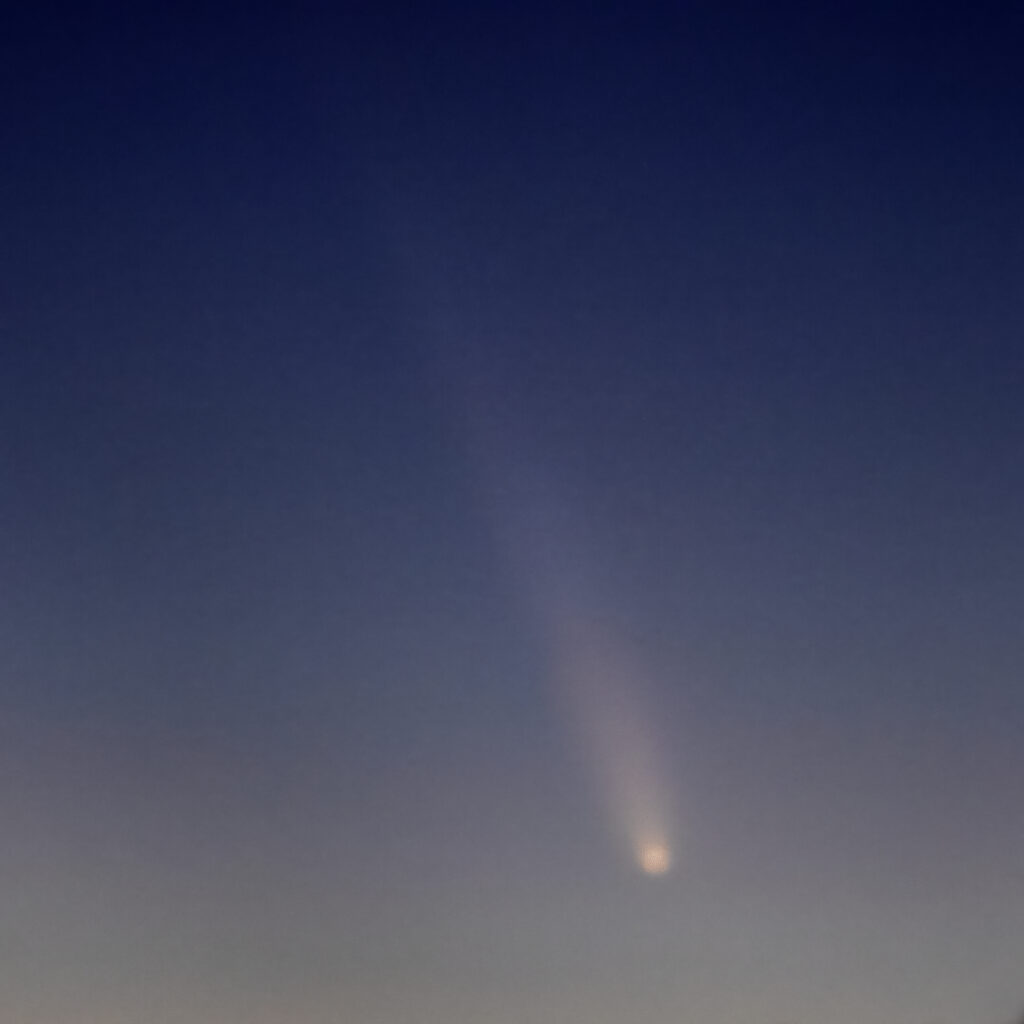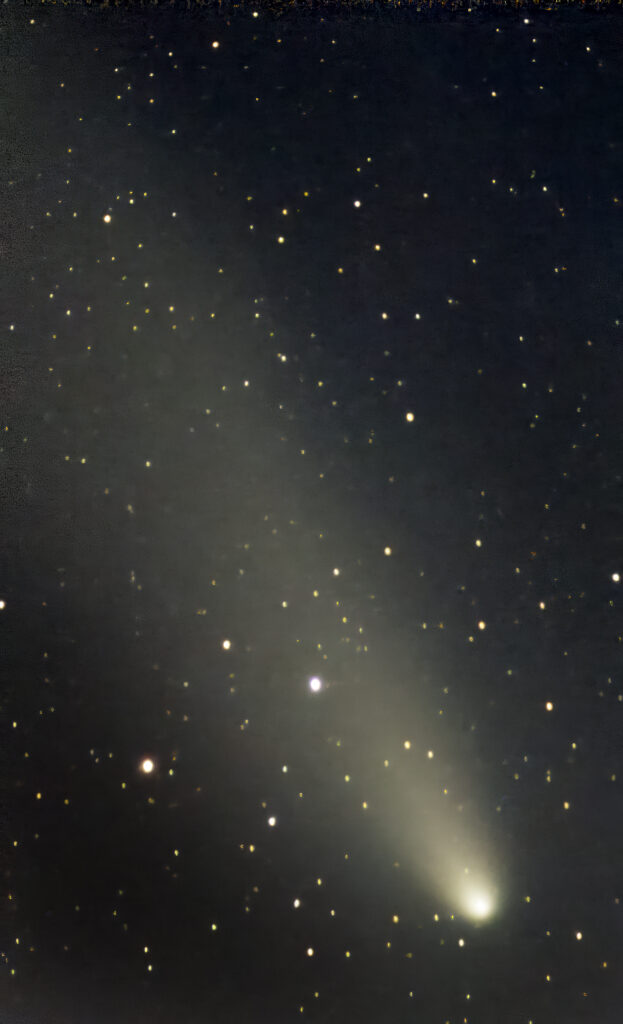
Figure 1 – Comet C/2023 A3 – Tusuchinshan Atlas from Spy Pond in Arlington, MA, ISO 800, 1 sec F/4 70 – 200 mm Zoom on October 12, 2024. (c) DE Wolf 2024
When I was teenage Davy and obsessed with astronomy I dreamt with wonder at the coming of Comet Halley in 1986. I was to be an impossibly old man at that date, although not as old as I would be at the coming of the millennium. I waited and many things happened. Finally, one night I went out to find the great comet. I searched the sky, star map in hand, with my father’s binoculars. I remember the moment vividly.
“So the years spin by and now the boy is twenty
Though his dreams have lost some grandeur coming true
There’ll be new dreams maybe better dreams and plenty
Before the last revolving year is through.“
The Circle Game, Joni Mitchell
The 1986 appearance of Comet Halley, compared to it predecessors, was kind of a dud. And we were left to new dreams, since none of us would live to see Halley come again.
“Comets are like cats: they have tails, and they do precisely what they want.”
David H. Levy
Fortunately, there have been other comets, which have lived up to the dream and mystery. In 2024, we were graced this fall with the appearance of Comet C2023 3A Tusuchinshan-Atlas – so wonderful! TC and I went out to Spy Pond in Arlington, MA. She wisely waited in the car listening to Bach, while I stood with a small crowd of nerdy Cambridge people waiting and stared in the chilly, setting light at the brilliance of Venus hovering above the horizon. Then we say it!
For comets in twilight, where the goal is to capture as much of the tail as possible I like to set up my Canon T6 with my 70 to 200 mm zoom on a tripod and take a wide open shot at something like 10 seconds. Figure 1 is the result, a spectacular comet against a cream blue sky.
Truly this comet was not a disappointment. Comets have captivated humanity for millennia, inspiring awe and curiosity. These icy visitors from the far reaches of the solar system have been the subject of myths, legends, and scientific studies alike. They have been seen as harbingers of change, foretelling great battles won and lost.
“When beggars die, there are no comets seen: the heavens themselves blaze forth the death of princes.”
To the Elizabethans, who believed that the world was meant to be static the sudden appearance of these hairy mysteries could be terrifying.
As Hamlet says, “Time is out of joint. Oh cursed spite, that ever I was born to set it right.”
At their core, comets are icy bodies that orbit the Sun. They are composed primarily of frozen water, gases, and dust. Unlike planets or asteroids, comets have highly elliptical (elongated) orbits, which means they spend much of their time far from the Sun before making a dramatic, close approach.
When a comet gets near the Sun, the heat causes its ices to sublimate (change directly from solid to gas), releasing gas and dust into space. This process creates a glowing coma (a cloud of gas and dust) and often a bright, visible tail that points away from the Sun.
Comet tails, in fact, come in three distinct types, each created by different interactions between the comet, the solar wind, and the Sun.
Dust Tail:
This is the most visible and often the brightest tail. The dust tail forms from small, solid particles (mostly dust) that are released as the comet’s icy nucleus heats up and begins to sublimate as it gets closer to the Sun. These particles are pushed away from the Sun by the pressure of sunlight. The dust tail tends to be broad and curved, following the comet’s orbit.
Ion Tail (Plasma Tail):
The ion tail is created when the comet’s gases (mostly water vapor, carbon dioxide, and other compounds) ionize due to the intense ultraviolet radiation from the Sun. The solar wind then carries these charged particles away from the comet, forming a tail that always points directly away from the Sun. The ion tail is often faint and blue due to the ionized gas, and it’s more straight compared to the dust tail.
Antitail:
This one is a bit more unusual. An antitail occurs when the comet’s orbit is such that, from our perspective on Earth, the ion tail appears to point in the opposite direction to the Sun. This phenomenon can happen when the comet is moving away from the Sun and the ion tail is still pushed by the solar wind. The antitail appears as a faint feature, and it’s not visible in all comets. But it was brilliantly visible with comet C/2023 3A.
Comets are believed to be leftovers from the early solar system. They are said to be “cosmic time capsules,” When our Sun and planets formed about 4.6 billion years ago, the outer regions of the solar system were home to many icy bodies that never coalesced into planets or moons. These icy bodies, known as cometary nuclei, contain some of the most primitive material in the solar system and are thought to have been preserved in their original state since the formation of the solar system.
There are two main regions in the solar system where comets originate: The Kuiper Belt: Located just beyond Neptune, the Kuiper Belt is home to short-period comets, which have orbits that last less than 200 years. These comets come from a relatively stable region and are believed to be remnants from the solar system’s early years. The Oort Cloud: A much more distant and hypothetical region, the Oort Cloud is thought to be a vast sphere of icy bodies that could contain long-period comets (those that take more than 200 years to orbit the Sun). These comets are often sent into the inner solar system by gravitational interactions with nearby stars.
These are just some basic facts about comets. Along with asteroids, they are very ancient objects which present in an unspoiled way the very beginnings of our solar system four plus billion years ago, We can visit them now, and in so doing sample our very own origins. Always there is the wonderful dichotomy between the physics of comets and the metaphysics of wonder at these cosmic voyagers some visiting us over and over again with clocklike regularity; others fleetingly passing us but once.
“Old men and comets have been reverenced for the same reason: their long beards, and pretences to foretell events.”
Jonathan Swift

